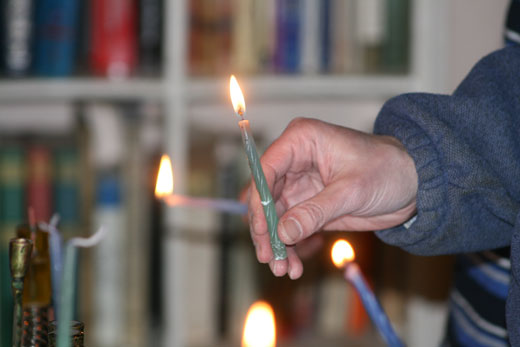Shamash, Nibbles and On the Blog

Chanuka is over, until next year, but I still have photos to share! This one is of the shamash; my husband and my three children are all holding their own as they say the bracha (blessing) before lighting the candles. The shamash is the helper and does not count as one of the 8 lights of Chanuka.
Yesterday I went to a lovely party. Some child had taken a whole plate of fancy chocolate candies and had nibbled exactly one bite out of each one. My friend the hostess was not amused. She considered putting up a sign: for adults only. I said maybe the parent should eat the candy if the child wants to try. Of course, then my daughter took one bite of a chocolate covered marshmallow candy without realizing it was marshmallow, and I had no interest in eating it. What do you think?
I loved this: do you hear in your house – “Are you going to put that on the blog?“

Mrs. S. says
Lovely shot! That's very interesting that your husband and kids recite the brachot together. Our family's custom is that one after the other - from oldest to youngest - each person recites the brachot and then lights the chanukiyah on their own (i.e. "in series" rather than "in parallel" :-) ).
Thanks for the link, and have a wonderful week!
Leora says
Because we go to a Sephardi shul, we learn about their customs, too. My husband told me Sephardim only light one chanukia per household.
Jew Wishes says
Reading about the nibbler reminds me why I don't like eating at buffets, especially after witnessing children doing exactly that.
Leora says
Oh, dear, too good a point.
Ilana-Davita says
I like the idea of everyone saying the brachot at the same time. I am not sure whether your comment implied that it is a Sephardi custom. Is it? Or just a family minhag?
Leora says
No, our custom is to light 4 chanukiot, one for each child (that is old enough to light) and one for my husband (I'm happy to enjoy all of theirs). It sounds like Mrs. S. does similar in the numbers of chanukiot in her household. We just differ in when we say the brachot.
The Sephardi custom is to have only 1 chanukia in the entire household. So there is only 1 bracha as there is only one chanukia.
Ilana-Davita says
I should have thought of that. Sigh.
EG Wow says
The photo is beautiful and so is the custom, whichever way it's celebrated.
annie says
I learned an interesting little bit about the variation of customs today. I wander if the variation grew out of a difference in the wealth of a particular community and then evolved from there?
Had to laugh at the tiny single bites, Leora. Such a typical child thing that is to experience. I've heard of it before but never experience it myself. What a photo op that would have been though I doubt if the party hostess would have agreed. :-)
Blessings to you all,
Annie
Leora says
"Such a typical child thing that is to experience." What a sweet approach. Yes, my friend the hostess didn't see it this way... (and I wouldn't dare mention it, either, unless she happens to read this post).
Mrs. S. says
Actually, the difference between the Ashkenazi and Sephardic customs is derived from the Gemara (BT Shabbat 21b*) - which teaches that the mitzvah of Chanukah is "one candle per person".
The Gemara then adds that the "mehadrin" (i.e. the "embellished" or "adorned" custom) is "one candle for each and every person" and that the "mehadrin min hamehadrin" (loosely, the "super embellished" custom) is - according to Beit Hillel - to light one candle on the first night and then to add one candle each night.
The question is: Does the "mehadrin min hamehadrin" apply to the basic mitzvah or to the "mehadrin"? According to the Sephardic interpretation of the Gemara, it's the former, but according to the Ashkenazi interpretation, it's the latter.
_________
*BTW, I based my recent parody on this Gemara.
Leora says
Thanks - I wonder how much of this Annie will understand! I appreciate the knowledgeable answer.
Mrs. S. says
Yeah, I realize that it's kind of obscure - to say the least! - but who knows? Maybe someone out there will one day be searching for this information, and now they can get it from your post... :-)
Leora says
I mentioned your scholarly explanation to my middle son and husband last night, and I got even more explanation.
It seems that the Sephardim follow Tosfot, who is Ashkenazi, and the Ashkenazim follow the Ramban, who is Sephardi. Got that? But then, middle son continued, the Ramah (who is Ashkenazi) learned from the Ramban, and Tosfot was the basis for the Shulhan Aruh (which is Sephardi).
I hope I got that right. ;-)
Mrs. S. says
Mostly right. :-)
The Sephardim follow the Shulchan Aruch (R' Yosef Karo), who - in this case - follows the Ashkenazi Tosafot.
Meanwhile, the Ashkenazim follow the Rama (R' Moshe Isserles), who - in this case - follows the Rambam (Maimonides - not the Ramban (Nachmanides)).
This is unusual, because in general, the Shulchan Aruch tends to follow the Rambam, and the Rama doesn't.
Leora says
Oh.
Please leave a comment! I love to hear from you.